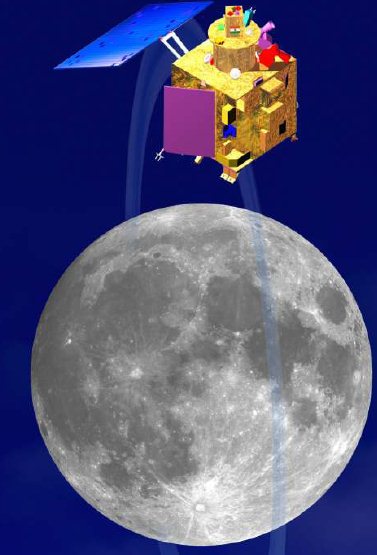Payload for Chandrayaan-2 finalized - Will try out new Ideas
 |
| Chandrayaan 2 Will Drop a Rover on to Moon Surface - In Chandrayaan 1 it was an Impact Probe |
After a successful Chandrayaan I mission ISRO is now all geared up for Chandrayaan II. India's first lunar mission Chandrayaan-1 had accomplished nearly 95 per cent of its scientific objectives and is considered a success internationally. It's on board NASA instrument made a buzz by confirming the presence of water/ice on Moon.
The Chandrayaan mission II is targeted in 2013. ISRO recently finalised the payloads that are to be flown onboard Chandrayaan II . Chandrayaan 2 will have an orbiter (satellite), a lander and a rover. Chandrayaan-2 is planned to be launched onboard Geosynchronous Satellite Launch Vehicle (GSLV) from Satish Dhawan Space Centre, Sriharikota. While the lander will be provided by Russia, the orbiter and the rover are being built by ISRO.
The payloads to be flown onboard Chandrayaan2 (orbiter and rover) have been finalised by a National committee of experts drawn from ISRO centres, academic institutions and R & D laboratories and Chaired by Prof U R Rao, Chairman, Advisory Committee on Space Sciences (ADCOS) and former Chairman of ISRO.
The committee, after detailed deliberations and considering the mission requirements, weight and power available for scientific payloads, has recommended five payloads to be flown on the orbiter of which three are new and two are improved versions of the payloads flown earlier on Chandrayaan1 orbiter. The committee has also recommended two scientific payloads on the rover of Chandrayaan 2. Inclusion of additional payloads, if possible within the mission constraints, will be considered at a later date following a detailed review.
"Right now, the weight problem is very serious", Mr. U R said indicating that foreign payloads may not be included at all. "We just don’t have the weight. We cannot select payloads which cannot go".
But Rao said one or two additional Indian payloads might be included. "Obviously, we will give preference to Indian payloads now. We have to provide as much opportunities as possible to Indian scientists".
But he said the Russians would conduct experiments with their lander. Rao said Chandrayaan-2 would carry out experiments based on the discoveries of its predecessor. "It will conduct extremely good experiments, try out very new ideas and new technologies."
Unlike the lunar probe of Chandrayaan-1 which plunged into the moon, the Russian-designed lander will make a soft touchdown and release the rover, which will travel a few metres to collect lunar rocks and other materials. The scientific payloads on the rover will analyse surface elements on the moon and send the data to the orbiter, which eventually sends them to the earth station.
The five recommended payloads of Chandrayaan-2 orbiter are as follows:
- Large Area Soft X-ray Spectrometer (CLASS) from ISRO Satellite Centre (ISAC), Bangalore and Solar X-ray Monitor (XSM) from Physical Research Laboratory (PRL), Ahmedabad for mapping the major elements present on the lunar surface.
- L and S band Synthetic Aperture Radar (SAR) from Space Applications Centre (SAC), Ahmedabad for probing the first few tens of meters of the lunar surface for the presence of different constituents including water ice. SAR is expected to provide further evidence confirming the presence of water ice below the shadowed regions of the moon.
- Imaging IR Spectrometer (IIRS) from SAC, Ahmedabad for the mapping of lunar surface over a wide wavelength range for the study of minerals, water molecules and hydroxyl present.
- Neutral Mass Spectrometer (ChACE2) from Space Physics Laboratory (SPL), Thiruvananthapuram to carry out a detailed study of the lunar exosphere.
- Terrain Mapping Camera2 (TMC2) from SAC, Ahmedabad for preparing a three-dimensional map essential for studying the lunar mineralogy and geology.
The two scientific payloads on Chandrayaan-2 rover are:
- Laser Induced Breakdown Spectroscope (LIBS) from Laboratory for Electro Optic Systems (LEOS), Bangalore
- Alpha Particle Induced X ray Spectroscope (APIXS) from PRL, Ahmedabad.
Both the instruments are expected to carry out elemental analysis of the lunar surface near the landing site.
Chandrayaan-2 spacecraft weighs about 2,650 kg at lift-off of which the orbiter weight is about 1,400 kg and lander weight is about 1,250 kg. Development of the subsystems of the orbiter and the rover is in progress at ISRO centres in Bangalore, Thiruvananthapuram and Ahmedabad.
But why a moon mission more than half a century after the Soviet Union landed Luna 2 on the lunar surface in 1959 and 41 years after the US put the first man on the moon in 1969? "The last moon mission was in the 1970s and we don't have access to much of that data. The dozens of moon missions by other countries could not find water on the moon, which Chandrayaan-1 did. So we can rightfully expect some new findings," said Satish ( ISRO Spokesperson) .
So I wish the Rs 425 Crore Chandrayaan 2 will create more ripples in the scientific and layman communities world wide finding something more
extraordinary
